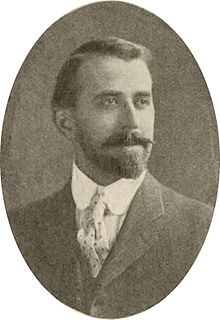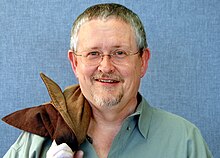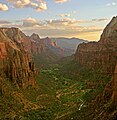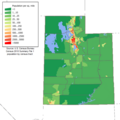The Utah Portal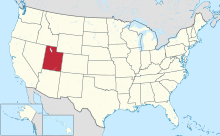  Utah (/ˈjuːtɑː/ YOO-tah, /ˈjuːtɔː/ YOO-taw) is a landlocked state in the Mountain West subregion of the Western United States. It borders Colorado to its east, Wyoming to its northeast, Idaho to its north, Arizona to its south, and Nevada to its west. Utah also touches a corner of New Mexico in the southeast. In comparison to all the U.S. states and territories, Utah, with a population of just over three million, is the 13th largest by area, the 30th most populous, and the 11th least densely populated. Urban development is mostly concentrated in two regions: the Wasatch Front in the north-central part of the state, which includes the state capital, Salt Lake City, and is home to roughly two-thirds of the population; and Washington County in the southwest, which has somewhat more than 180,000 residents. Most of the western half of Utah lies in the Great Basin. Utah has been inhabited for thousands of years by various indigenous groups, such as the ancient Puebloans, the Navajo, and the Ute. The first Europeans to arrive - in the mid-16th century - were the Spanish. Because of the region's challenging geography and harsh climate, it only became a peripheral part of New Spain (and later of Mexico). Even while it was Mexican territory, many of the Utah region’s earliest European settlers were from the United States; notable among these were Mormons who were fleeing marginalization and persecution in the United States and arrived via the so-called Mormon Trail. In 1848, after the Mexican–American War, the region was annexed by the U.S., becoming part of the Utah Territory, which included what later became Colorado and Nevada. Disputes between the dominant Mormon community and the federal government delayed Utah's admission as a state: in 1896, after it agreed to outlaw polygamy, it was admitted as the 45th state. People from Utah are known as Utahns. Slightly over half of all Utahns are Mormons, the vast majority of whom are members of the Church of Jesus Christ of Latter-day Saints (LDS Church), which has its world headquarters in Salt Lake City; Utah is the only state where a majority of the population belongs to a single church. The LDS Church greatly influences Utahn culture, politics, and daily life, though since the 1990s the state has become more religiously diverse as well as secular. (Full article...) Entries here consist of Good and Featured articles, which meet a core set of high editorial standards.
Ralph Vary Chamberlin (January 3, 1879 – October 31, 1967) was an American biologist, ethnographer, and historian from Salt Lake City, Utah. He was a faculty member of the University of Utah for over 25 years, where he helped establish the School of Medicine and served as its first dean, and later became head of the zoology department. He also taught at Brigham Young University and the University of Pennsylvania, and worked for over a decade at the Museum of Comparative Zoology at Harvard University, where he described species from around the world. Chamberlin was a prolific taxonomist who named over 4,000 new animal species in over 400 scientific publications. He specialized in arachnids (spiders, scorpions, and relatives) and myriapods (centipedes, millipedes, and relatives), ranking among the most prolific arachnologists and myriapodologists in history. He described over 1,400 species of spiders, 1,000 species of millipedes, and the majority of North American centipedes, although the quantity of his output was not always matched with quality, leaving a mixed legacy to his successors. He also did pioneering ethnobiological studies with the Goshute and other indigenous people of the Great Basin, cataloging indigenous names and cultural uses of plants and animals. Chamberlin was celebrated by his colleagues at the University of Utah, however he was disliked among some arachnologists, including some of his former students. After retirement he continued to write, publishing on the history of education in his home state, especially that of the University of Utah. (Full article...)Selected image - 227 (plate number) East and West Shaking Hands at Laying Last Rail. Andrew J. Russell photo after the Golden Spike ceremony.
August selected anniversaries
Selected biography -Orson Scott Card (born August 24, 1951) is an American writer known best for his science fiction works. He is (as of 2024) the only person to have won a Hugo Award and a Nebula Award in consecutive years, winning both awards for his novel Ender's Game (1985) and its sequel Speaker for the Dead (1986). A feature film adaptation of Ender's Game, which Card coproduced, was released in 2013. Card also wrote the Locus Fantasy Award-winning series The Tales of Alvin Maker (1987–2003). Card's fiction often features characters with exceptional gifts who make difficult choices with high stakes. Card has also written political, religious, and social commentary in his columns and other writing; his opposition to homosexuality has provoked public criticism. (Full article...)Selected article -The Utah War (1857–1858), also known as the Utah Expedition, the Utah Campaign, Buchanan's Blunder, the Mormon War, or the Mormon Rebellion, was an armed confrontation between Mormon settlers in the Utah Territory and the armed forces of the US government. The confrontation lasted from May 1857 to July 1858. The conflict primarily involved Mormon settlers and federal troops, escalating from tensions over governance and autonomy within the territory. There were several casualties, predominantly non-Mormon civilians. Although the war featured no significant military battles, it included the Mountain Meadows Massacre, where Mormon militia members disarmed and killed about 120 settlers traveling to California. The resolution of the Utah War came through negotiations that permitted federal troops to enter Utah Territory in exchange for a pardon granted to the Mormon settlers for any potential acts of rebellion. This settlement significantly reduced the tensions and allowed for the re-establishment of federal authority over the territory while largely preserving Mormon interests and autonomy. (Full article...)Did you know -
Selected panorama - Downtown Salt Lake City, Utah in 1913, looking east along 200 South from West Temple Street. To the far left is the Salt Lake Temple. The very white building right of the Temple is Hotel Utah, about one year old at the time. Just visible on the right side of the photo is the Salt Lake City and County Building clocktower. The Wasatch Mountains are in the background.
TopicsCategoriesGeneral imagesThe following are images from various Utah-related articles on Wikipedia.
State facts
State symbols:
Featured contentArticles:
Lists:
Pictures: Related portals
Lists
Related WikiProjectsNew articlesThis list was generated from these rules. Questions and feedback are always welcome! The search is being run daily with the most recent ~14 days of results. Note: Some articles may not be relevant to this project.
Rules | Match log | Results page (for watching) | Last updated: 2024-08-25 22:18 (UTC) Note: The list display can now be customized by each user. See List display personalization for details.
Things you can doAssociated WikimediaThe following Wikimedia Foundation sister projects provide more on this subject:
Discover Wikipedia using portals |
